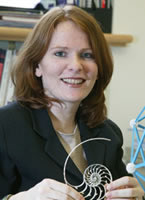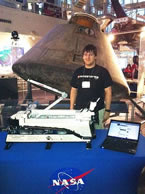|
| |
|

|
|

|
|
Dr. Judy Holdener
|
|
Mr. Andy Miluzzi
|
|
Dr. Judy Holdener
|
|
|
Kenyon College
|
|
|
Biography:
|
Judy Holdener joined Kenyon's Mathematics Department in 1997, after spending three years at the U.S. Air Force Academy in Colorado Springs, CO. Although her primary research interests are in the areas of algebra and number theory, she has been known to work in other areas when an interesting question arises... especially if the question is accessible to undergraduates. Judy has collaborated with students on research projects relating to algebra, number theory, dynamical systems, and mathematical biology; their work has culminated in research publications and presentations at national math conferences. In 2008, Judy was awarded the Mathematical Association of America Ohio Section Distinguished Teaching Award and in 2003, she was awarded Kenyon's Tomsich Science Award as well as the Board of Trustees Junior Teaching Award. Judy will spend her 2012-13 sabbatical as a visiting professor at Carnegie Mellon University in Pittsburgh.
|
|
|
Title:
|
Why math is fun: convergence, connections and the great unknown
|
|
|
Abstract:
|
Mathematics is sometimes defined as the science of pattern, and mathematicians are experts in recognizing and quantifying pattern. The pattern might reside in the physical world (say, for example, in recognizing the parabolic shape of projectile motion), or the pattern might exist entirely within the realm of the mathematician's abstract world (say, for example, in recognizing that all even perfect numbers are multiples of a Mersenne prime.) Regardless of the pattern to be explored, the mathematician is somebody who is deeply engrossed in making connections: connections between the physical and the abstract, connections between the geometric and the analytic and the algebraic, connections between what is known and what is unknown. In this talk I will explain why I find mathematics to be so much fun, and I will share some surprising connections I have experienced with my students. Along the way I will present some research done by my students and reveal how their work connects to the work of Archimedes, Marston Morse, Axel Thue, and Helge von Koch.
|
|
|
Title:
|
Perfect and Abundant Numbers – a Perfect and Abundant Source for Undergraduate Research Projects
|
|
|
Abstract:
|
In June of 2009, the 47th perfect number was discovered by the Great Internet Mersenne Prime Search (GIMPS), a collaborative computing project involving volunteers from all over the world. Like all known perfect numbers before it, this number is even. Does an odd perfect number exist? Are there infinitely many perfect numbers? After more than 2000 years of study, the answers to these questions remain unknown. In my talk, I will introduce perfect numbers along with the closely related "abundant numbers". After presenting some relevant background information, I will reveal some of the abundant mystery surrounding these perfectly intriguing figures and report on some of the results discovered in recent years by undergraduates at Kenyon College. In doing so, I hope to illustrate that number theory is fertile ground for students itchin' to get involved in answering open questions in mathematics.
|
»
BACK TO TOP
|
Andy Milluzzi
|
|
|
Rose-Hulman Institute of Technology
|
|
|
Biography:
|
Andrew Milluzzi is a Senior Computer and Software Engineer at Rose-Hulman. In his spare time he is one of 50 engineers, scientists, artists, and inventors that bare the title LEGO MINDSTORM Community Partner. Andrew travels the world working with children and adults on various LEGO projects. From robots to buildings to everything in between, Andrew works to inspire the next generation of scientists, mathematicians and engineers.
|
|
|
Title:
|
LEGO: The Intersection of Art and Engineering
|
|
|
Abstract:
|
LEGO Bricks are one of the most popular building toys. From artists to engineers, the freedom of expression that LEGO Bricks provide is legendary. What makes this medium so creative? The simple fact is that LEGO Bricks can be assembled in more permutations and combinations than you can imagine. This talk will look at how such a design can lead to so many different ideas. From one small 1x1 stud brick to the legendary 2x4 stud brick, these pieces fit together in so many different ways.
|
»
BACK TO TOP
|
|
|